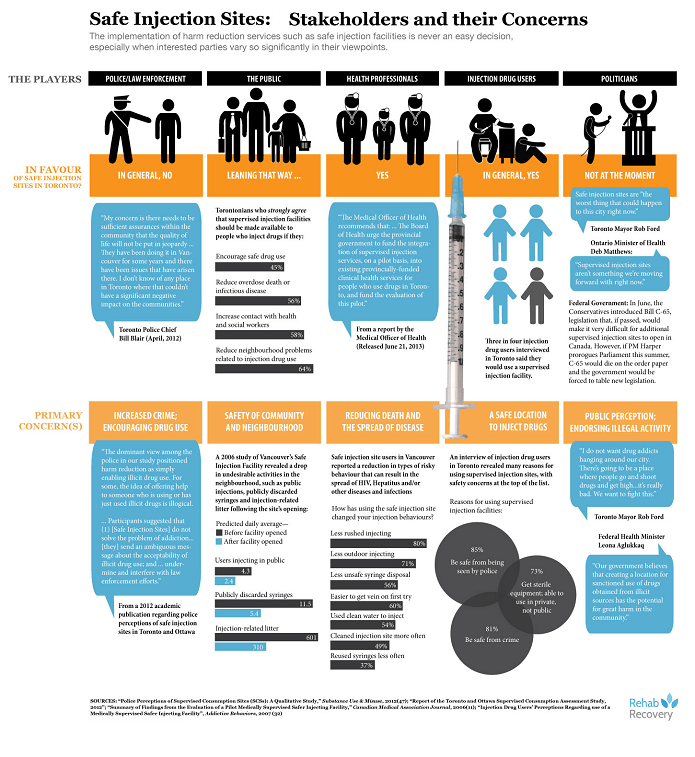Safe Injection Sites – Pros and Cons [INFOGRAPHIC]
Over the past couple of years, there has been significant growth in safe injection sites across North America, as well as countries in Europe and Australia [1].
This rapidly growing phenomenon has elicited controversy and heated debate among policymakers, health experts, and drug rehabilitation centres.
While supporters of safe injection sites applaud this growing trend as an additional aid to combating opiate addiction, critics insist that safe injection sites only further exacerbate the drug problem.
If your loved one is affected by an addiction problem, naturally, you will be inclined to agree with the opponents of safe injection sites.
The truth of the matter, however, is that there are far too many parameters to factor in, which makes the debate far more complex.
In this article, we are going to examine the issue of safe injection sites and the ramifications that this new trend has on the opioid epidemic.
We will discuss some of the merits and demerits of these institutions in a comprehensive manner, to enable you to make an informed choice.
What are Safe Injection Sites?
Safe injection sites are legally sanctioned and medically supervised facilities that provide a hygienic, safe and secure environment for users of intravenous drugs to imbibe on their illegally acquired substances.
The facilities are also known by other names such as overdose prevention centres, medically supervised injection centres, supervised consumption services, and fix rooms [1].
Most well-established supervised injection sites are usually served by qualified medical professionals who provide sterile equipment for use by drug users and clean up after them.
They also make referrals to drug rehab centres, where users can seek help for their addiction problems.
However, safe injection sites, in principle, do not sell or provide drugs to users.
Most supervised injection sites typically stock up on overdose prevention medications and are able to respond quickly in case of emergencies such as overdose, to prevent fatalities.
Supervised injection centres are designed to help reduce the risk of death from drug overdoses [2].
In light of the opiate epidemic, which has wreaked havoc in many parts of the world, these facilities are considered a saving grace by many people.
However, while safe injection sites have the potential to fight drug addiction, they also contribute to the problem in a number of ways. In light of this, it may be wise for us to examine the degree to which these facilities are effective.
How Effective are Safe Injection Sites
For many years, health experts have advocated for the use of harm reduction strategies such as needle exchange programs to fight the opioid epidemic.
However, it is not until very recently that policymakers have begun to seriously consider safe injection sites as a strategy in the war on opiate addiction.
Although safe injection sites may not be the complete solution to the opioid crisis, they nonetheless have the potential to reduce drug use and save lives.
Studies conducted over a period of a decade have revealed that harm reduction measures such as needle exchanges help reduce the number of bloodborne infections such as HIV and Hepatitis C [3].
In addition to this, the use of needle exchange programs in safe injection sites also helps reduce the number of syringes thrown in public [4], thereby minimizing the risk of second-hand needle use by users who cannot afford to buy new ones.
Also, supervised injection facilities dramatically reduce the risk of fatal overdoses from drug addiction [5].
These centres are usually properly stocked up with overdose prevention medication such as Naxalone, which are used in case of overdose-related emergencies.
Similarly, safe injection facilities act as links between opiate addicts and rehab centres.
Many users of intravenous opiates have been able to receive support and assistance to overcome their addiction by being referred to rehabilitation facilities by the staff of supervised injection facilities.
Despite the effectiveness of safe injection sites, they are still very limited in their efforts to combat addiction, and in some cases, they may even be counterproductive to the efforts to end the opioid epidemic.
Safe Injection Sites Infographic
The below infographic outlines various concerns expressed by different groups of people in society. This infographic presents different opinions on safe injection sites and vastly different points of view on the matter.
Please click on the infographic image link below to access the full-size image:
The Pros of Safe Injection Sites?
Safe injection sites are still a subject of controversy in the countries most affected by the opioid crisis.
Many lawmakers are still split on whether the approach of harm reduction as employed by supervised injection facilities is truly beneficial.
In truth, the existence of safe injection sites can be very beneficial to opiate addicts and the affected communities in a number of ways.
These include:
1. Providing a Safe Space for Users of Intravenous Drugs
Safe injection sites are primarily beneficial because they offer a safe space for opiate addicts to inject their drugs.
Rather than injecting drugs in public spaces, where they can be a nuisance and a health hazard, drug users can inject themselves in a hygienic and safe environment.
This helps prevent the public and especially highly susceptible individuals such as school-going children and teenagers from being exposed to harmful drugs.[6]
2. Prevent Overdose-Related Fatalities
The illicit use of opiates such as heroin seriously endangers the lives of its users, since they can die of an overdose at any given time.
Safe injection sites can help remedy this problem by responding promptly to any drug-related overdose, and administering overdose-reversing medicines to victims in order to prevent fatality.
3. They Help Drug Addicts to Access Treatment
Safe injection sites act as links between drug rehabilitation facilities and the addicts who are desperately in need of treatment.
Staff members of safe injection sites are able to establish relationships with addicts and help them access treatment from rehab centres.[7]
4. They Reduce the Risk of Deadly Diseases
The all-too-common practise of sharing needles among drug addicts is, undoubtedly, one of the main causes of deadly bloodborne diseases such as HIV and Hepatitis [3].
To help prevent the spread of these infections, safe injection sites usually employ the use of strategies such as needle exchange programs.
They also educate drug addicts on the risks associated with sharing needles, thus helping drug addicts develop safe injection practices.
The Cons of Safe Injection Sites?
Although safe injection sites are potentially beneficial to the war on opiate addiction, they nonetheless pose many risks and disadvantages, which are necessary to highlight.
Some of the cons associated with supervised injection sites include:
1. May Encourage Drug Use in Addicts of Intravenous Drugs
Many ardent opponents of safe injection sites argue that these facilities may end up encouraging drug use rather than serving as a deterrent.
By providing drug addicts with safe spaces to inject themselves, they may end up becoming more complacent in an activity which is not only potentially fatal but also illegal.
2. May Frustrate Federal Control
The proliferation of safe injection sites may potentially make it difficult or impossible for policymakers to enforce laws against drugs.
Many critics of supervised injection sites express concerns that creating a uniform regulatory law for safe injection sites may be infeasible or, at the very least, very difficult to achieve.[8]
3. May Increase the Rate of Drug-Related Crime in Nearby Communities
Safe injection sites may potentially pose a security concern in the communities where they are located.
The ease with which users will be able to imbibe on illegal drugs will cause an influx of drug peddlers and dealers in these areas.
As a result, drug-related crimes are likely to increase in the neighbourhoods where safe injection sites operate.
4. May Strain Government Budgets
Another cause of concern about safe injection sites is that they are going to strain the budget of most affected countries.
Establishing safe-injection sites which are up to standards, cost a lot of money. Many countries that decide to adopt this policy typically end up spending a significant chunk of taxpayers money to construct supervised injection facilities, staff them, and equip them with the necessary medications.
The common everyday citizen will essentially be funding the addictions of others, which is something that no one wants to do.
In Conclusion
The role of safe injection sites in the opioid epidemic is, without a doubt, one of the most divisive issues in modern times.
Many lawmakers and experts have debated whether they are beneficial or detrimental to the war on drugs. The answer to that question depends on who you ask.
However, the positive effects of supervised injection centres cannot be understated. These facilities provide a safe haven from victims of drug addiction to use their drugs in a hygienic, secure, and non-judgmental environment.
They also provide addicts of intravenous drugs with information on safe injection practices, which can help minimise the risk of deadly bloodborne infections.
In addition to this, safe injection sites save lives by responding promptly to overdose cases in order to prevent fatalities.
Although supervised injection sites may enable drug use, they nonetheless educate drug users on the harmful effects of intravenous drugs and encourage them to seek treatment in drug rehab centres.
If you struggle with opiate addiction or know a loved one who does, then you will no doubt welcome the growing presence of safe injection sites.
References
[1] https://doi.org/10.1016/j.amepre.2017.06.010
[2] https://www.wbur.org/commonhealth/2017/06/16/ama-supervised-injection-facilities-opioids
[3] https://onlinelibrary.wiley.com/doi/full/10.1111/j.1753-6405.2009.00389.x
[4] https://www.cmaj.ca/content/171/7/731
[5] https://onlinelibrary.wiley.com/doi/abs/10.1111/j.1360-0443.2009.02837.x
[6] https://doi.org/10.1016/j.drugalcdep.2014.10.012
[7] https://onlinelibrary.wiley.com/doi/abs/10.1111/j.1465-3362.2009.00025.x
[8] https://ajph.aphapublications.org/doi/10.2105/AJPH.2006.103747





